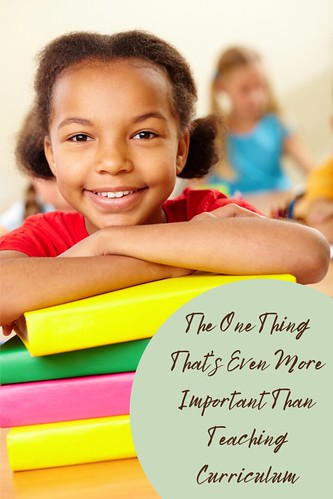The One Thing That’s Even More Important Than Teaching Curriculum
All children are unique. They have unique lives, with unique lived experiences and opportunities. They have unique strengths, needs, and interests. They have unique family units, backgrounds, and identities.
In schools, these unique children come together and share a learning environment.
As teachers, we must find ways to embrace the uniqueness of the students we teach, while creating learning opportunities based on a singular curriculum.

With the extensive nature of the curriculum and the busyness of the role, it is easy to understand how the curriculum becomes a checklist of things we must do. In our efforts to do our jobs and cover the curriculum, we plow through full steam ahead. I talk about this in my book New Teacher Confidential: What They Didn’t Tell You About Being a Teacher.
In doing so, we know that not every student has grasped the current concepts or fully developed their understanding of the material, but we are forced to carry on and move forward through the mandated curriculum expectations.
Without the necessary supports in place for students that need more time or assistance to learn the curriculum, their learning gaps grow with each school year. At some point, many of these students start to lose their self-esteem and label themselves as ‘dumb’.
From that point on, school becomes a stressor that they must endure, day-in and day-out. Daily, they are reminded of their deficits which are put on full display for others to see—teachers, their parents, and even classmates.
This current reality begs the question: do we teach students, or do we teach curriculum?
When you further consider that in any given classroom there will be children who:
• Come to school tired, hungry, or with other basic needs unmet.
• Have undiagnosed medical conditions, learning disabilities, or mental health issues.
• Have experienced trauma.
• Do not speak English at home or have moved to a new country.
• Feel unsafe or unloved.
We need to take a good look at our current education system.
While having a streamlined, common teaching curriculum isn’t necessarily a bad thing, we need to keep the focus on the fact that we teach children. Our education system needs to account for the abundance of different learners that we have in our classrooms and provide supports and opportunities for our diverse communities.
In the meantime, as teachers, we need to prioritize teaching our students over teaching the curriculum. By doing so, we can move the focus back to where it needs to be, on the development of children.
This starts with building genuine connections with the students we teach; that we learn as much as we can about them individually. When we know our students well, we show up for them differently. This will be imperative for the life trajectory of some of the students we teach.
Building a connection means knowing little things about them: the sports they play, the names of their pets, the types of books they like to read or their hobbies.
It also means knowing their personalities well enough to know when something is amiss. It means creating trusting relationships and safe spaces. It means ensuring they know we care about them, regardless of their academic performance.
How do we do this?
We can do this in many ways.
1. We can set the example by allowing our students to get to know us. We can share small tidbits about ourselves that humanize us and help students feel like they can connect. Give them updates on your favourite sports team, tell them about your pets, or have pictures of your family on your desk.
2. Be ready and available when they arrive at school in the morning. Stand at the classroom door, greet each student by name, use this time to take each student’s ‘temperature,’ and look for those that may not be school-ready.
3. Take opportunities for individual interactions throughout the school day. Allow students to tell you a story, a joke, about their new favourite song. Notice things that are important to them such as their drawing, new shoes, or the book they’re reading. Catch them doing things well like helping a friend, being kind, or solving a problem.
4. Recognize when to prioritize mental health over academics.
When students genuinely know that we care about them and that they are in a safe, supportive environment with their basic needs met, we can then begin to focus on curriculum.
As an education system, we must keep our focus where it belongs: on our students.
Shannon Hazel is a recently-retired public school teacher and the author of the upcoming book New Teacher Confidential: What They Didn’t Tell You About Being a Teacher. Over her 25-year career, she was a K-8 teacher, special education specialist and instructional coach for teachers. During that time, she was actively involved in the Elementary Teachers Federation of Ontario and mentored many new teachers. In 2023, Shannon was recognized for her leadership and advocacy work for students by the Council for Exceptional Children. She is the founder of teacherEDU.ca, an online community for teachers to learn, connect, collaborate, and grow their capacity as educators. Shannon is the mother of two young adults, a dog parent, and a longtime fan of the Kansas City Chiefs.
Find her online at
https://www.teacheredu.ca/
https://www.instagram.com/teachereducommunity/
https://www.facebook.com/teacheredu.ca/

-

- Log in to post comments


















